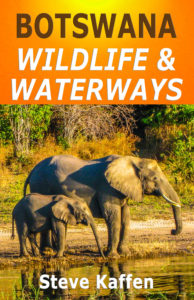BOTSWANA WILDLIFE & WATERWAYS by Steve Kaffen (Russia)
Botswana is one of Africa’s great showplaces. It has the continent’s largest concentration of wildlife and the largest elephant population. It also has a network of strikingly beautiful waterways and scenic landscapes. The country has benefited from sustained political stability and an economic policy that has balanced growth and development with environmental sensitivity. Author and explorer Steve Kaffen takes readers to two Botswana highlights, Chobe National Park and the Okavango Delta, with revealing photographs of animal and birdlife in natural surroundings, pristine waterways, varied landscapes, and local lifestyles.
Steve writes in his introductory note: “Africa is exhilarating. I feel a rush of energy upon arrival. I soon encounter the first African smile–huge, warm, and genuine–welcoming me back. I love the feeling of freedom, the open spaces, the unfiltered conversations and hospitality, and the naturally beautiful places. The entire experience is enveloping.”
Amazon.com will be offering the book free Friday (11/13) and Saturday (11/14). It’s an opportunity to “buy” the book at a $0.00 price.

Several years ago, my husband and I visited the same places in Botswana as the author. At the first camp site, a herd of elephants brushed the canvas sides of our tent as they searched for anything green just before the wet season. The wildlife changed, depending upon the terrain, from giraffes, zebras, impala, Cape buffalo, to wild dogs, hyenas leopards and cheetahs. And, we never forgot the families of lions. Our last camp was located on the Zambezi River between Namibia and Botswana.where we watched the hippos. Lest I forget, and I should have mentioned this first, the Batswana (plural form ) were welcoming and warm hearted. .Eager to read the book.
Those are fascinating memories. Most of the book’s photos are from the period you mention, the dry season, when the animals spend their days near water. I recall the elephants that waded, 3/4 deep, and looked like strange-shaped water-rocks; their protruding trunks gave them away. The social hippos that you mention did an “S&S,” submerge and snort, that you could hear up and down the river. I was in Peru 20 years after you, arriving by Amazon riverboat in Iquitos, for Inti Raymi, the Sun Festival in Cuzco. You are fortunate to have lived and done your service there.